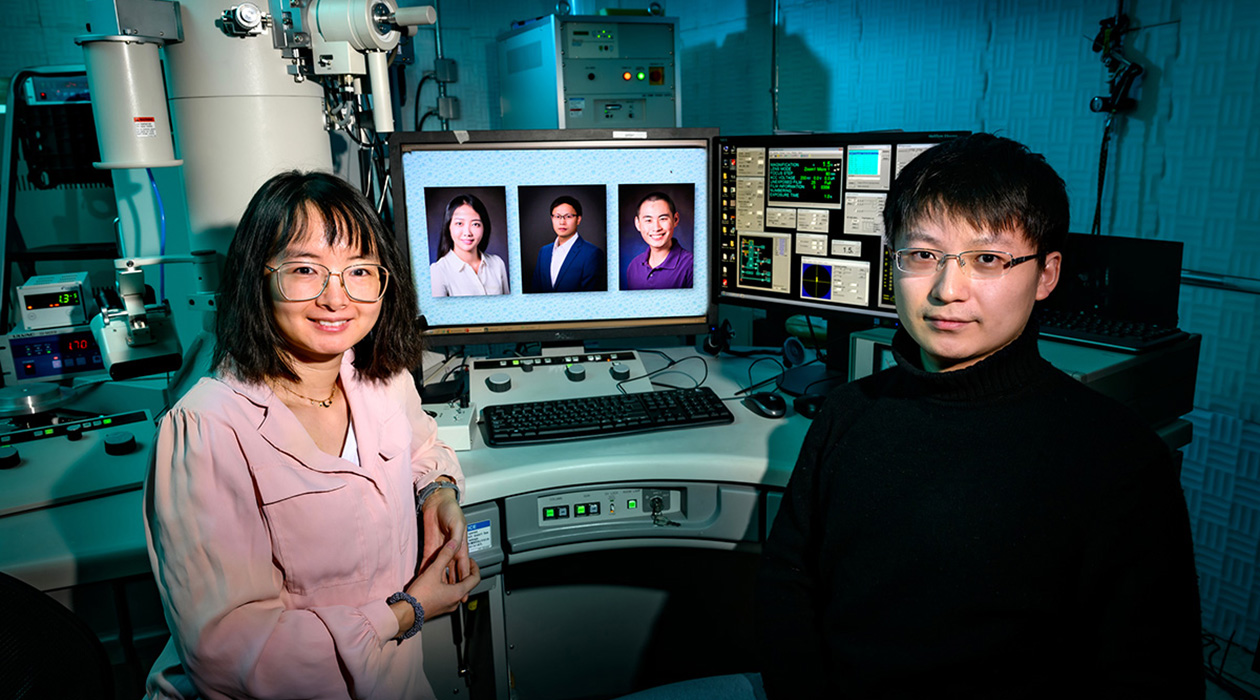Researchers reveal real-time glimpse into growth habits of nanoparticles

Professor Qian Chen, left, onscreen researchers Ahyoung Kim, Binbin Luo and Ahyoung Kim, and Chang Liu, seated, collaborated with researchers at Northwestern University to observe nanoparticles self-assembling and crystalizing into solid materials for the first time. / Fred Zwicky
For the first time, researchers have observed the process of nanoparticles self-assembling and crystalizing into solid materials. In new videos produced by the team, particles can be seen raining down, tumbling along stairsteps and sliding around before finally snapping into place to form a crystal’s signature stacked layers.
Led by Qian Chen (M-CELS) at the University of Illinois Urbana-Champaign and Erik Lutijen at Northwestern University, the study used liquid-phase transmission electron microscopy and computational modeling to gain an unprecedented view of the self-assembly process at nanometer resolution. The team said these new insights could be used to design new materials, including thin films for electronic applications.
The findings are published in the journal Nature Nanotechnology.
Before this work, researchers used microscopy to watch micron-sized colloidal particles – 10 to 100 times larger than nanoparticles – self-assemble into crystals. There are also extensive theories on atomic, molecular or ionic building blocks, which are 10 to 100 times smaller than nanoparticles. However, the researchers said a knowledge gap existed at the intermediate nanoscale.
Recent advances to improve liquid-phase TEM have made it possible to view nanoparticles in real time as they form solid materials. Chen’s team spent years optimizing the process to ensure the electron beam could view the particles without damaging them.
“Previously, our team resolved the mystery of nucleation, namely how the embryos of crystals composed of tens of nanoparticles are formed,” said Chen, a materials science and engineering professor at the University of Illinois Urbana-Champaign, who led the experimental work. “With advances in liquid-phase TEM and data science, in this work, we can now capture and track motions of thousands of nanoparticles over time.”
In the new study, researchers used differently shaped nanoparticles – cubes, spheres and indented cubes – to explore how shape affects behavior.
“We know that atoms use a similar scheme to assemble into crystals, but we have never seen the actual growth process,” said Luijten, a materials science and engineering professor at Northwestern who led the theoretical and computational portion of the study. “Now we see it coming together, right in front of our eyes. By viewing nanoparticles, we watch particles larger than atoms but smaller than colloids. So, we have completed the whole spectrum of length scales. We are filling in the missing length.”
In experiments by Illinois graduate students Binbin Luo, Chang Liu, Ahyoung Kim and Zihao Ou, the particles collided, sticking together to form layers. The particles formed a horizontal layer and then stacked vertically to form the layer-by-layer crystalline structure. Sometimes, after sticking to each other, the particles briefly detached to fall onto a layer below. They further visualized crystal formation with advanced computer simulations, verifying the universal trend of distinctive assembly structures from different-sized particles.
“The differently shaped nanoparticles we used wiggle around and communicate differently with each other while in fluids. We sampled their growth behaviors from hundreds of liquid-phase TEM movies to glean a unified understanding for the first time,” said Luo, a former Illinois graduate student, first author of the study and currently with Dow Chemical Company.
“The movies have a huge amount of information embedded,” said Ou, a former Illinois graduate student who is currently at Stanford University. “We taught our computers to extract the position, shape and the networks they assemble into over time automatically, allowing us to translate the movies to quantifiable physical parameters.”
Kim, a former Illinois graduate student and currently at the University of California, Berkeley, said one unique advantage of nanoparticles is that their shapes and surface chemistry can be facilely changed by synthesis. Liu, a graduate student in the Chen group added, “We studied cubes, spheres and indented cubes; they diffuse differently as they chase after each other, leading to different final shapes of the crystals.”
Luijten said this information will help engineers design new materials. The insight could help design thin-film materials often used to build flexible electronics, light-emitting diodes, transistors and solar cells.
“Knowing how particles come together will enable us to control the shape of a surface,” Luijten said. “Do you want a flat or rough surface? Changing particle shape or how fast the particles fall can affect the surface.”
The U.S. Department of Energy and the National Science Foundation supported the research.
Chen also is affiliated with the Materials Research Laboratory, chemistry, chemical and biomolecular engineering, and the Beckman Institute for Advanced Science and Technology at the U. of I.
This is a modified version of a news release distributed by Northwestern University. The paper “Unravelling crystal growth of nanoparticles” is available online. DOI: 10.1038/s41565-023-01355-w
